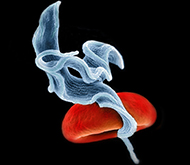Projects |
The elusive molecular biology of the vault RNA
In human diseases caused by viruses, host cell infection is a tightly controlled process with regulated temporal expression of viral as well as cellular genes. It has been shown recently that virus infection indeed changes the RNA expression profile also on the ncRNA level. We recently investigated the small ncRNA transcriptome of human B cells to identify ncRNAs expressed from the viral or cellular genome upon Epstein-Barr virus (EBV) infection. EBV, a DNA virus of the herpesvirida family with a linear double-stranded genome of about 172 kb, is associated with a heterogeneous group of human tumors including Burkitt’s lymphoma.
In our recent genomic ncRNA screen we have identified 21 novel as well as previously reported ncRNA species to be up-regulated during virus infection. Especially intriguing was the identification of the B-cell encoded vault complex-associated RNAs (vtRNAs). vtRNAs have been reported previously to serve as integral parts of the so-called vault complex, a large hollow barrel-shaped RNP complex with a size of 13 MDa (Figure 3). This gigantic complex is by far the largest cellular RNP identified to date and its dimensions would theoretically allow the transport of cargo of the size of the ribosome. The vtRNAs were the most strongly up-regulated RNA class in EBV infected B cells. Very little is known about the function of this ncRNA class, mainly because the vault complex has been overlooked for many years.
Click figure to enlarge
In this project we would like to address the question whether the vtRNA up-regulation is causally linked to the virus infection and which function the vtRNAs might possess during virus establishment and propagation. Furthermore we are assessing the structure-function relationship of vtRNAs. Collectively these data will eventually reveal the so far enigmatic molecular biology of this interesting ncRNA species.


